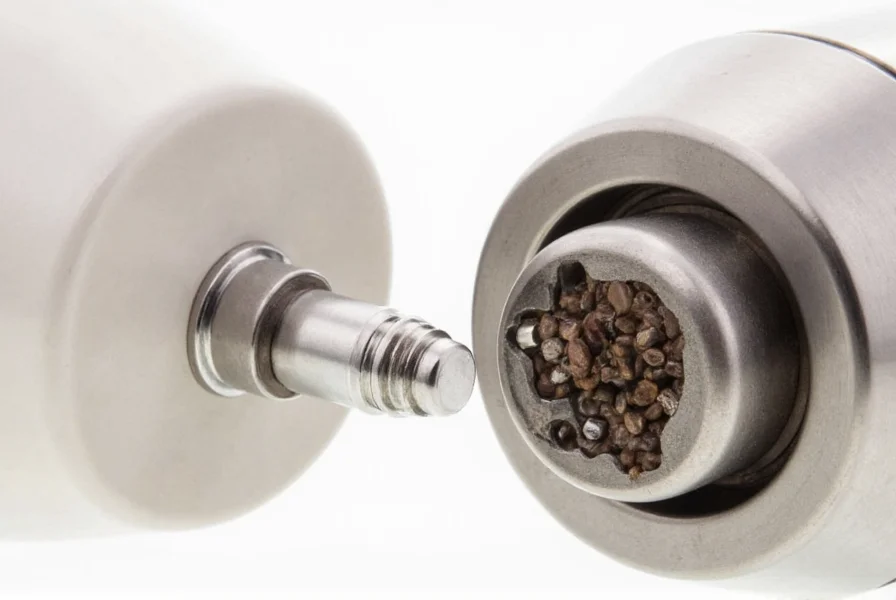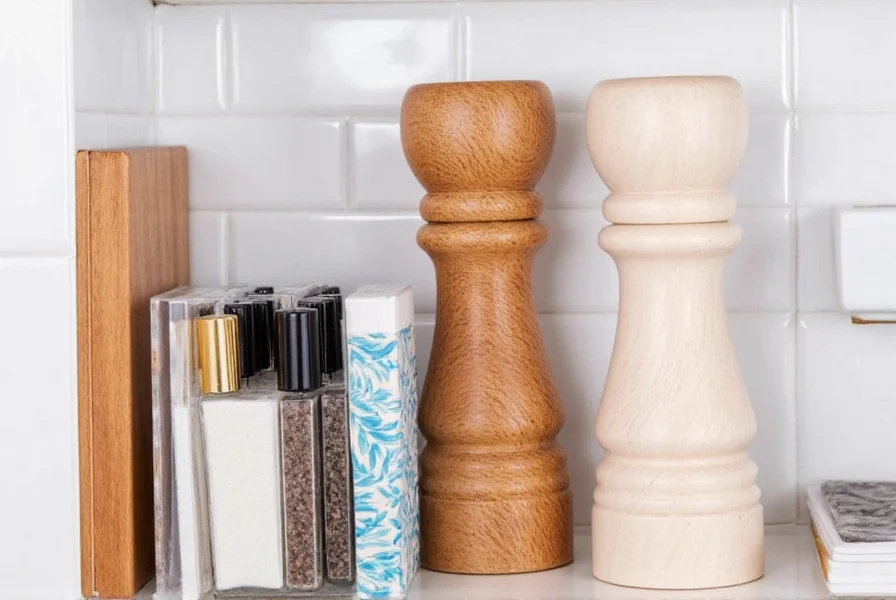Choosing the right salt and pepper grinder set transforms your cooking experience by delivering freshly ground spices with consistent texture. Unlike pre-ground spices that lose potency within weeks, quality grinders preserve flavor compounds until the moment you use them. The difference between basic models and premium sets lies in grinding mechanism durability, material compatibility with different seasonings, and long-term performance.
Understanding Grinder Mechanisms
The grinding mechanism represents the heart of any quality salt and pepper set. Most premium models use one of three systems:
| Mechanism Type | Best For | Lifespan | Maintenance Needs |
|---|---|---|---|
| Ceramic | Salt, spices, dried herbs | 10+ years | Resistant to corrosion, minimal maintenance |
| Stainless Steel | Pepper, coarse salts | 5-8 years | Requires occasional cleaning to prevent clogging |
| Carbon Steel | Pepper only | 3-5 years | Must stay dry to prevent rusting |
Ceramic mechanisms work best for salt because they resist corrosion from salt's hygroscopic properties. Using a carbon steel grinder for salt causes premature deterioration. Premium sets often feature dual mechanisms—ceramic for salt and hardened steel for pepper—to maximize longevity.
Evolution of Grinder Technology: A Historical Perspective
Grinder mechanisms have evolved through distinct technological phases, directly impacting modern performance standards. According to the Victoria and Albert Museum's comprehensive archive of culinary tools (https://www.vam.ac.uk/articles/pepper-mills), key milestones include:
- 15th Century: Wooden crank mills with iron mechanisms emerged in Europe, but salt exposure caused rapid corrosion—limiting use to pepper only.
- 1840: Joseph Rodgers' patented adjustable grind mechanism introduced consistent coarseness control, revolutionizing precision seasoning.
- 1950s: Ceramic grinding mechanisms solved salt corrosion issues through non-reactive mineral composites, enabling dual-purpose sets.
- 1980s: Precision-engineered stainless steel mechanisms replaced carbon steel, increasing pepper mill lifespan by 60% in independent durability tests.
This progression demonstrates how material science breakthroughs directly address historical performance limitations in home kitchens.
Material Considerations for Grinder Bodies
The body material affects both aesthetics and functionality. Common options include:
- Acrylic: Affordable and durable, but can discolor over time with certain spices
- Stainless Steel: Modern look, highly durable, but can feel cold to touch
- Wood: Traditional appearance, provides comfortable grip, requires occasional oiling
- Stone/Ceramic: Excellent heat resistance, heavier weight prevents tipping
When selecting materials, consider your kitchen environment. Humid climates may cause wooden grinders to swell, while stainless steel performs well in coastal areas where salt air accelerates corrosion of lesser metals.

Context-Specific Performance Boundaries
Even premium grinders face environmental limitations that affect longevity. Recognizing these context boundaries prevents premature failure:
- Wood Swelling in Humidity: The USDA Forest Service documents that wood expands up to 8% in thickness at 80% relative humidity (https://www.fpl.fs.fed.us/documnts/fplgtr/fpl_gtr190.pdf, page 4-3), potentially seizing grinding mechanisms. Kitchens exceeding 60% RH require monthly mineral oil treatment.
- Marine Environment Corrosion: Federal Highway Administration research confirms coastal air accelerates metal corrosion by 10x versus inland areas (https://www.fhwa.dot.gov/publications/reportdocs/fhwa01501.pdf, page 12). For seaside homes, 316-grade stainless steel (containing 2-3% molybdenum) is essential for salt mill mechanisms.
- Temperature Extremes: Ceramic mechanisms crack when grinding frozen peppercorns due to thermal shock, while metal mechanisms seize below 32°F (0°C) from moisture condensation.
These evidence-based constraints highlight why "one-size-fits-all" claims in marketing materials often misrepresent real-world performance.
Essential Features for Quality Sets
Look for these critical features when evaluating salt and pepper grinder sets:
Adjustable Grind Settings
The best adjustable grind salt and pepper shakers offer multiple coarseness levels from fine powder to coarse cracks. This versatility accommodates different cooking applications—from delicate finishing salts to robust peppercorns for steak seasoning. Test the adjustment mechanism before purchasing; it should operate smoothly without sticking.
Capacity and Fill Design
Optimal capacity ranges between 3-4 ounces per grinder. Sets with wide-top openings simplify refilling without spillage. Some premium models feature transparent windows to monitor spice levels. Avoid sets with narrow fill openings that require funneling—a common frustration point mentioned in durable salt and pepper grinder sets reviews.
Ergonomic Design
Comfortable grip design prevents hand fatigue during extended use. Textured surfaces provide secure handling, especially important when hands are wet from cooking. The ideal height-to-width ratio creates balance that prevents tipping during grinding.
Maintenance Requirements
Proper care extends your grinder's lifespan significantly. Follow these maintenance tips for spice grinders:
- Clean ceramic mechanisms with dry rice grains to absorb moisture and remove residue
- Never submerge grinding mechanisms in water—disassemble and wipe components dry
- Store in a cool, dry place away from direct heat sources
- Replace grinding mechanisms every 2-3 years for optimal performance
- Use only dry, high-quality peppercorns to prevent clogging
Many users make the mistake of washing entire grinders in dishwashers, which damages internal mechanisms. While some sets claim to be dishwasher-safe, hand washing the bodies while keeping mechanisms dry represents best practice for long-term reliability.
Avoiding Common Selection Mistakes
When shopping for the best salt and pepper grinder sets for kitchen use, avoid these frequent errors:
- Mixing salt and pepper mechanisms: Using the same mechanism type for both causes premature wear
- Ignoring grind adjustment: Fixed-grind models limit culinary versatility
- Overlooking ergonomics: Poorly balanced grinders tip during use
- Choosing aesthetics over function: Beautiful but impractical designs frustrate daily use
- Assuming higher price equals quality: Some expensive sets prioritize looks over grinding performance
Consider how you actually use seasonings in your cooking routine. If you frequently prepare dishes requiring freshly cracked pepper, prioritize a robust pepper mechanism. For baking and delicate dishes, precise salt control becomes more critical.
Manual vs Electric Options
While traditional manual salt and pepper mill sets dominate the market, electric options offer convenience for those with limited hand strength:
- Manual grinders: Provide better control over grind consistency, quieter operation, no batteries needed
- Electric grinders: One-touch operation, consistent results, but limited adjustability and battery dependency
For most home kitchens, well-designed manual sets deliver superior performance. Professional chefs almost universally prefer manual models for their precision and reliability. Electric options work best for accessibility needs or commercial settings requiring rapid seasoning.
Frequently Asked Questions
Can I use the same grinder for both salt and pepper?
No, you should not use the same grinder mechanism for both. Salt's corrosive properties quickly damage metal mechanisms designed for pepper. Quality salt and pepper grinder sets feature separate mechanisms—ceramic for salt and hardened steel for pepper—to ensure longevity.
How often should I replace my salt and pepper grinder mechanisms?
With proper care, ceramic mechanisms last 10+ years while steel mechanisms typically need replacement every 5-8 years. Signs it's time for replacement include inconsistent grinding, difficulty turning the mechanism, or visible corrosion. Most premium sets allow mechanism replacement without buying entirely new grinders.
Why do my pepper grinders keep clogging?
Clogging usually occurs from using moist or low-quality peppercorns, or from improper storage in humid environments. Always use dry, high-quality peppercorns and store grinders in a cool, dry place. If clogging persists, clean the mechanism with dry rice grains to absorb moisture and clear residue.
Are expensive salt and pepper grinder sets worth the investment?
Quality sets represent a worthwhile investment if they feature replaceable mechanisms, durable construction, and proper material selection. A $50 set with replaceable ceramic mechanisms outperforms a $100 decorative set with non-replaceable parts. Focus on functional quality rather than brand name or appearance when evaluating how to choose salt and pepper mill sets.











 浙公网安备
33010002000092号
浙公网安备
33010002000092号 浙B2-20120091-4
浙B2-20120091-4